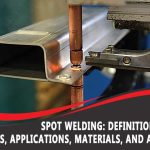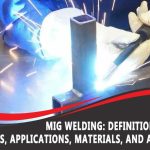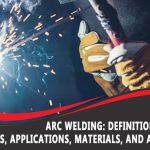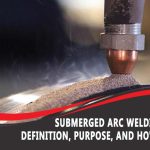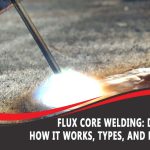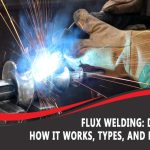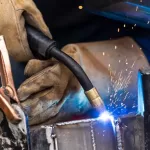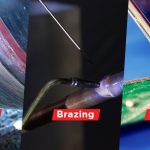There are a ton of little details in welding that make a surprising amount of difference. Some are obvious – the gas composition, the voltage, and the frequency of the electrical arc – while others may be less obvious. One of those less obvious details is the differences between forehand and backhand welding.
Forehand vs Backhand MIG Welding
Welding Town
What are they, what are their differences, and when should you use one over the other? Let’s talk about it.
What is Handedness in Welding?
First, a simple definition. What is handedness in welding? We’re not talking about welding with the left hand or the right hand here. Instead, it’s about the angle of the torch relative to the workpiece and the direction of movement relative to the angle of the torch. Beyond this, it’s also important to know where the filler rod is in relation to the other factors.
While we did say that it doesn’t have anything to do with which hand you hold the torch in, that can actually be an important factor. Forehand welding with the left hand versus forehand welding with the right hand can be different in direction and angle, as long as the motion of travel is still consistent relative to the angle and position of the torch. Generally, you should always use your dominant hand for obvious reasons.
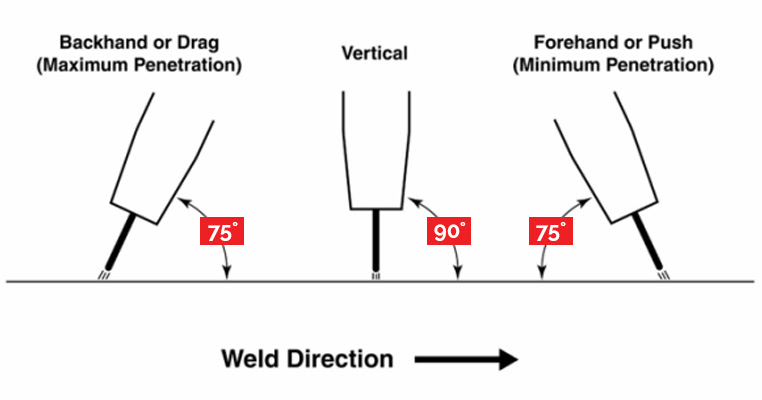
Forehand Welding
Forehand welding is a technique in welding where the filler rod is placed in front of the torch. With this technique, the operator holds the torch at about a 30-degree angle, leaning “back” away from the filler rod. The direction of travel is “pushing” towards the filler rod, melting it, and passing over it and the joint. The torch itself is positioned over the completed weld bead and your progression of the weld pushes out. For this reason, forehand welding is also known as push welding.
Backhand Welding
With backhand welding, the opposite is true. It’s also known as pull welding. The torch is dragged along the weld seam, dragging and melting the baseplates before the filler rod is melted over the top. The angle is the same or shallower, sometimes closer to a 30-45-degree angle, while the direction of travel is different from forehand welding.
Vertical Welding
The third kind of welding is vertical welding. This is welding where the torch is held directly perpendicular to the workpieces and direction of travel, at a perfect or near-perfect 90 degrees. This is, as you might expect, the middle ground between the other two kinds of welding. It has neither the pros nor the cons of either of the two extremes and is a good standard position for welders to use when they don’t need one of the benefits or to avoid one of the drawbacks of either forehand or backhand welding.
Similarities Between Forehand and Backhand Welding
Both the forehand process and the backhand process are arc welding techniques, and can be done with MIG and other forms of welding. They were primarily developed for gas welding, but can be used in just about every form of arc welding. Almost every weld can be done in either forehand or backhand movement, but there are some differences between them that can make one more useful than the other. We’ll go through those in the next section.
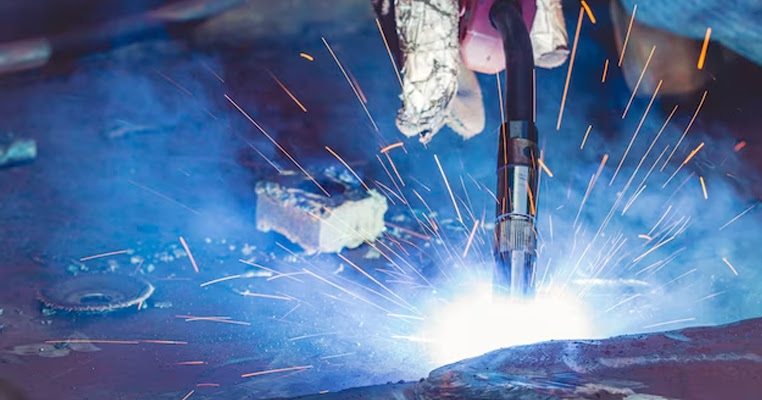
Neither of these techniques is inherently better than the other. They can both produce solid, clean results, or they can produce poor quality results, depending on the skill of the operator. All else being equal, the minor differences between the two aren’t hugely meaningful across the board, but can be important in specific circumstances.
Differences Between Forehand and Backhand Welding
Now let’s go through the differences between each of these welding techniques, and why they might matter to any given project you’re working on.
The angle of the torch. In forehand welding, the angle of the electrode is pointed towards the direction of the weld progression. A weld moving left will hold the torch at an angle so the tip is further to the left than the main torch, and the filler rod is ahead of its direction of travel, to the left of the tip of the torch. Conversely, in backhand welding, the same angle and configuration would be in place, except the direction of travel would be to the right.
Technically speaking, the forehand welding technique’s torch is held at an angle between 135 and 150 degrees – an obtuse angle – while in backhand welding, the torch is held at an acute angle of 30-45 degrees, relative to the feed vector. Again, this is easier to see in image or video than as described in text.
Position of the torch. Relative to the weld bead, the forehand welding technique places the torch above the completed weld bead. This can present a challenge in keeping the torch at an appropriate distance from the workpiece, as it can be harder to judge that distance when a still-hot weld beads beneath the torch. Conversely, the backhand weld technique travels over the unfilled root gap. This makes it slightly easier to see the positioning of the torch, though if you have a beveled or u-grooved root gap, that can present challenges of its own.
Where filler is deposited, with forehand welding, the filler metal is applied ahead of the torch. The torch essentially melts the filler metal into the workpiece, melting all of it at once and leaving a molten pool behind to mix and solidify on its own. With backhand welding, the filler metal is applied behind the torch, using not just the heat of the arc but the heat of the molten base metals to help melt and distribute the filler metal.
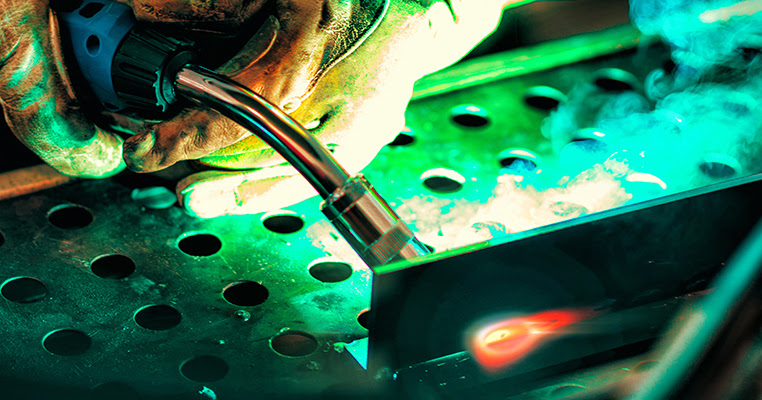
Effective pre-heating and post-heating. With the push mode of welding, the angle of the torch technically has a small amount of preheating for the material directly in front of the torch. With backhand pull welding, there’s no such preheating. However, this is a very minimal difference in arc welding and is much more applicable to similar forms of welding using oxyfuel torches or other direct heat application methods.
As you might imagine, the opposite is true of post-heating. The push method of welding does not reheat the materials. Conversely, in backhanded welding, the residual heat does a sort of post-heating and annealing effect. Again, this is more applicable to flame-based welding rather than arc welding.
The balance between deposition and penetration. Perhaps the biggest difference between forehand welding and backhand welding is the balance between two factors: the deposition rate of filler material and the penetration of heat to the workpieces.
Forehand welding, the push-mode form of welding, tends to allow for a faster feeding rate of filler material, which allows for a faster deposition rate for that filler material. This can allow for a fast weld across the length of a workpiece seam.
The trade-off to this faster deposition rate is that you don’t spend as much time in any one spot in the weld, which means you don’t have as much of a chance for deeper penetration. If you go too slow, though, you deposit too much material and end up with an oversized and ineffective weld bead that will likely require a lot more cleanup.
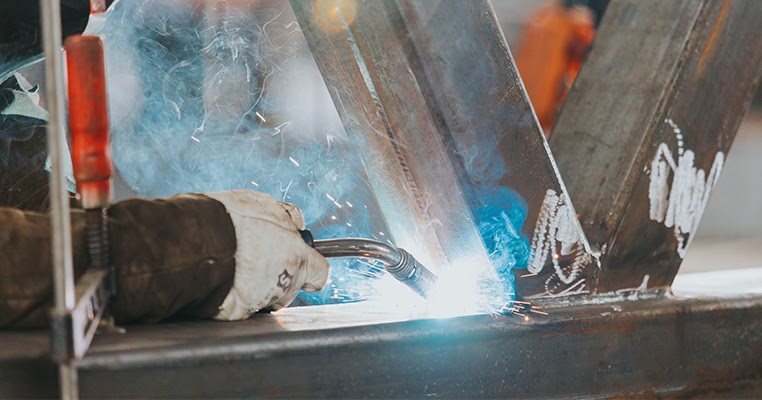
When you invert these factors for backhand welding, you can see how they vary. Backhand welding has the option for slower travel speed without ramping up the deposition of the filler material. This allows for deeper and better penetration of heat into the weld. However, because of the position of the filler rod, you don’t deposit as much material as quickly, so you can end up with shallow or too little filler added to the weld if you’re not careful.
Spatter and slag. Another significant difference between forehand and backhand welding is the spatter, slag, and general cleanliness of the weld you create. Unfortunately, forehand welding tends to have more spatter and dirtier welds, all else being equal. Conversely, backhand welding doesn’t produce as much slag and spatter.
Visibility. One of the factors we mentioned above is worth repeating: because of the position of the torch and the weld pool, forehand welding tends to offer better visibility of the area in front of the torch. It can be more difficult to see what’s under the torch in the weld pool itself, and since some issues can be diagnosed based on the color and behavior of the weld pool or its inclusions, this can be an issue. On the flip side, with backhand welding, visibility is a bit worse for the actual point of welding, but the results of the weld are clearer.
Thickness viability. Given the comparatively light penetration of forehand welding, it’s generally better used for joining up thinner plates or material that has been prepared to be thinner. It’s also possible to use this technique for multi-pass welding more easily. Conversely, the deeper penetration of backhand welding means it’s better for joining slightly thicker materials. Of course, for very thick or very thin materials, changing the position and direction of travel is generally not enough, and you will need to adjust other parameters, like the current you’re using.
Which Kind of Welding is Best for Your Purpose?
Deciding whether to use push welding or pull welding, forehand or backhand welding, depends a lot on your needs.
Generally, if you’re welding something where you need light deposition or deep penetration, such as thicker materials, you will be more likely to use backhand welding. Flipping it around, if you’re welding something that is quite thin or needs more deposition of filler material, you should use forehand welding.
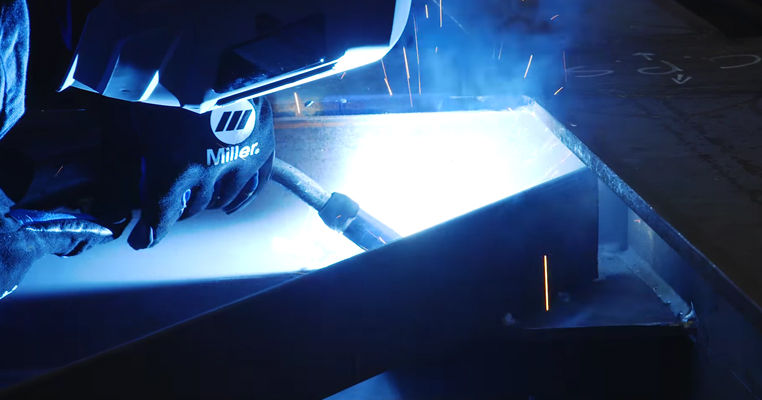
Forehand welding provides a greater degree of control over a comparatively small weld puddle and is often used for pipe welding. It often results in smoother welds, as long as the spatter isn’t an issue or is cleaned up. On the other hand, backhand welding is more useful when you have deeper or heavier plates that need to be joined together. While edge preparation can help minimize the need to change your technique, sometimes the technique is more effective to moderate.
The actual determination can often depend on the operator’s skills, visibility, and even the tools they’re using. One of the biggest drawbacks to push welding is that it can create more spatter because of an inconsistent arc, but there are some welding machines that can automatically detect and compensate for issues in the arc, minimizing this problem. Similarly, some torches are designed with better visibility than others, and some can have difficult angles to hold or view around the torch tip itself.
In many cases, when you’re unsure of which kind of welding to choose, the best option is to choose neither and go with vertical welding.
Overall, MIG welding is one of the easier processes and tends to be more forgiving of mistakes, including choosing the wrong kind of travel angle or handedness to your welds. If you were to try TIG welding using the same techniques, you might find a starker difference between them.
Using the Best Equipment
While your choice of handedness when MIG welding can be impactful, even the best technique and the best style of welding will falter if you’re using a low-quality, outdated, poorly maintained, or low-quality machine.
Your welding machine is the backbone of your welding operations, so it pays – sometimes literally – to have a good machine at hand.
- Is your current equipment old and due for an upgrade?
- Do some of the functions of your current welder not seem to work or do not work well?
- Are you burning through consumables at a faster rate than you should?
- Is it getting harder to find replacement parts for the machine you have?
- Could you benefit from advanced features like pulsed MIG or dynamic current adjustments?
If you’ve answered yes to any of these questions, there’s a good chance that it’s time to upgrade your machine. Fortunately, we’ve got you covered here. Our welding equipment gives you a bunch of different options for different welding machines, suitable for every possible need you may have. You can rent a machine, try it out, and if you like it, buy it for yourself. The choice is yours! We’re also always standing by to answer any questions you may have.


